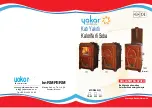
10
www.highvalleystoves.com
Section 6: Operating and Building an Efficient Fire
For the High Valley Model 1500
1.
Pull exhaust by-pass all the way open (top center handle).
2.
Push damper slides (left and right sides) all the way open, underneath hearth
plate. Push to open, pull to close.
3.
Burn out the flue by rolling up a piece of newspaper, lighting and holding in upper
rear portion of the firebox.
4.
Open door, twist newspaper into small rolls and place pieces of dry kindling on
top of newspaper. You are now ready to light the fire. After kindling is ignited and
burning, place larger wood into the fire.
5.
After temperature in the catalyst has reached 500 degrees, close the catalyst by-
pass. The blower will come on automatically after temperature at the thermostat
has reached 110 degrees.
6.
You may adjust the burn by pulling both sides 50% closed for medium burn, 75%
closed for low burn and pushed all the way open for 100% burn. (Push to open,
pull to close)
For the High Valley Model 2500
1.
Pull exhaust bypass all the way open (top center handle).
2.
Pull primary and under-fire damper slides all the way open. Primary is right side
underneath hearth plate, and under-fire is left side underneath hearth plate.
3.
Burn out flu by rolling up piece of newspaper, lighting, and holding in upper rear
portion of firebox.
4.
Open door, twist newspaper into small rolls and place small pieces of dry kindling
on top of newspaper. You are now ready to light the fire. After kindling is ignited
and burning, place larger wood onto the fire.
5.
After temperature in the catalyst has reached 500 degrees, close the catalyst
bypass damper. The blower will come on automatically after temperature at the
thermostat reaches 100 degrees.
6.
You may adjust the burn rate by pushing the primary handle 50% open for a low
burn, 75% open for a medium burn, and 100% open on high burn.
7.
Under fire may be closed for all burns with the exception of “start up”. High blower
speed is for high fire rate with primary and under fire air open 100%.
Maintenance
1. Blower Motor:
In the event of a power failure we recommend removing motor
to help natural convection, which will increase the life of the motor. If the motor
or thermostat fails to work, remove motor housing and return to your dealer for
servicing.
2. Stove Finish:
Your stove is finished with a high temperature, heat resistant paint.
There will be a slight odor of paint during the first burn, though not hazardous. A
door or window opened slightly will reduce fumes to a minimum.


































